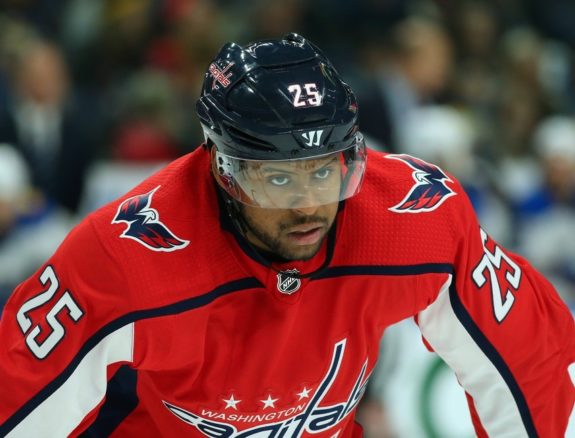Entering next season, the biggest shakeup in the Washington Capitals’ Stanley Cup-winning lineup will come on the fourth line. With the departure of Jay Beagle, who spent the better part of a decade pivoting the Capitals’ bottom trio, one of the Capitals’ most consistent lines in recent memory has lost its main constant.
Yet change is not always bad. Even if a nucleus-type player like Beagle can be difficult to replace. In fact, with an injection of young talent and some slight strategic adjustments, the Capitals could actually improve their fourth line despite the loss of Beagle. Here’s how.
Chandler Stephenson at Center
Which Capital will replace Beagle as the fourth line center remains a bit of a question mark. Young forward Chandler Stephenson seems somewhat groomed for the role. After all, Stephenson was the player Washington head coach Barry Trotz elected to serve as the third line center in the 2018 playoffs when Nick Backstrom was sidelined with a hand injury, forcing some line reshuffling.

While there are other options, such as free agency acquisition Nic Dowd, the Capitals should indeed go with Stephenson.
Stephenson has all the skills of a sturdy fourth line center. He was a mainstay on the Capitals penalty kill unit throughout the 2018 regular season and ensuing playoff run, showing defensive responsibility. Though Stephenson did not spend much time in the faceoff dot in his rookie campaign, he was reliable when called upon, winning 40 of his 73 draws in the regular season. His percentage dipped below 50% in the playoffs, but his regular season percentage is still evidence that he is perfectly comfortable taking faceoffs and will only improve with experience.
Though Beagle’s dependability and notorious faceoff prowess made him a prototypical depth center on the Capitals, there’s one element of the game where Stephenson would actually be an upgrade: skating. Stephenson burst onto the scene in the 2018 Stanley Cup Playoffs. The asset that allowed him to stand out? His speed.
When called upon, Stephenson was quick enough to keep up with the likes of Alex Ovechkin and Evgeny Kuznetsov on the Capitals top line, yet had the poise to be trusted in more defensive roles in the bottom six and on the penalty kill. Moreover, Stephenson skated into most of the clutch moments that truly put him on the map.
Stephenson is no slouch when it comes to the typical duties of a depth forward. But his explosiveness could bring a new element to the fourth line. While the Capitals can lean on him when they need to defend their own zone, his speed can help with zone exits and generate chances on the rush.
More Speed On the Wing
Last season, slower, more physical players like Alex Chiasson and Devante Smith-Pelly often occupied the wings on the Capitals fourth line. With Beagle out of the picture and Chiasson unlikely to return, there is now room for a younger winger to fill that role. There are three likely candidates for this spot. They all share Stephenson’s best asset.

The word ‘speed’ becomes redundant when discussing Capitals prospects Nathan Walker, Shane Gersich, and Axel Jonsson-Fjällby. But it’s the one word that always comes up.
Walker’s speed was noticeable in each of the handful of games he played in Washington during the 2017-18 season. It was most noticeable, however, in Game 6 of the Eastern Conference Semifinals against the Pittsburgh Penguins, his only playoff appearance.
Walker skated by the Penguins defense, got behind the net, and made a simple pass to Chiasson to set up the Capitals’ only regulation goal in their historic elimination of the Pittsburgh Penguins. It was the perfect example of how speed can benefit a depth player. He did not have to make a difficult play to create space, because his speed did it for him.
Gersich did not join the Capitals until late March, after his season at the University of North Dakota came to a close. He did, however, crack the lineup in a few playoff games over some more tenured pros. Though he certainly needs to acclimate to the physicality of the NHL, Gersich’s eye-catching speed likely earned him those looks in the most important time of the season.
Jonsson-Fjällby is a bit more of a dark horse, as this will be his first season in North America. He is a possibility nonetheless. Playing on Team Sweden’s fourth line at the 2018 World Junior Championships, Jonsson-Fjällby contributed two shorthanded goals. In the SHL playoffs later in the year, again on the fourth line, he contributed six goals and two assists in just 11 games. Jonsson-Fjällby’s size and strength have encouraged teams to place him in depth, defensive roles. Still, he uses his swift skating to generate offense from these roles.
There’s going to be a major preseason competition to determine which of these players earns a permanent spot in the lineup. It’s quite likely that all three will get some NHL action early in the season. If just one can demonstrate he is capable of fulfilling the common responsibilities of a depth forward, it could create a dangerous fourth line in Washington. With such a player next to Stephenson, the Capitals would have a fourth line that could defend its own zone while utilizing speed to generate offense.
The Capitals’ Finished Product
The one certainty on the Capitals fourth line going into next season is Smith-Pelly at right wing. As previously mentioned, Smith-Pelly is known more for his physicality than his skating ability. However, the Capitals’ top trio of Ovechkin, Kuznetsov, and Tom Wilson is a perfect example of how two faster players alongside more of a checker can still get up the ice quickly. Though obviously less skilled, the trio of Stephenson, one of the aforementioned prospects, and Smith-Pelly would have a similar identity.

The biggest argument against a depth line that is more fast than physical is that a team needs a physical line for defensive situations, such as a penalty kill or a key defensive zone draw. This does not tell the whole story. Sure, pure strength helps when clearing the crease. But clearing the crease is not the only element of defensive hockey.
Since the fourth line tends to be deployed on defensive zone faceoffs, one of its major tasks is exiting the zone. Speed and decision-making are the two elements of a clean zone exit. Good coaching can help the latter, but only a well-crafted line can create the former. A speed-oriented fourth line can get the puck to the offensive end of the ice. Teams win when they play on the offensive end of the ice.